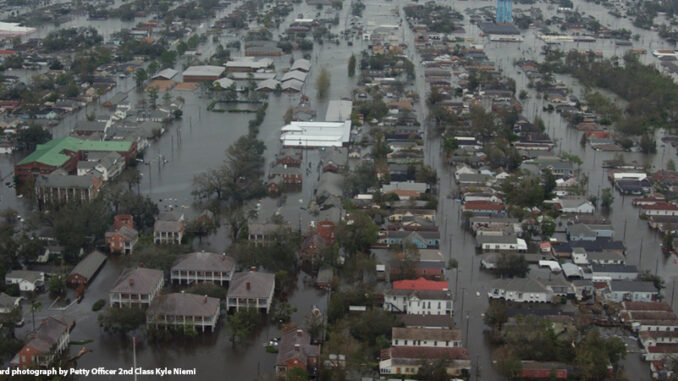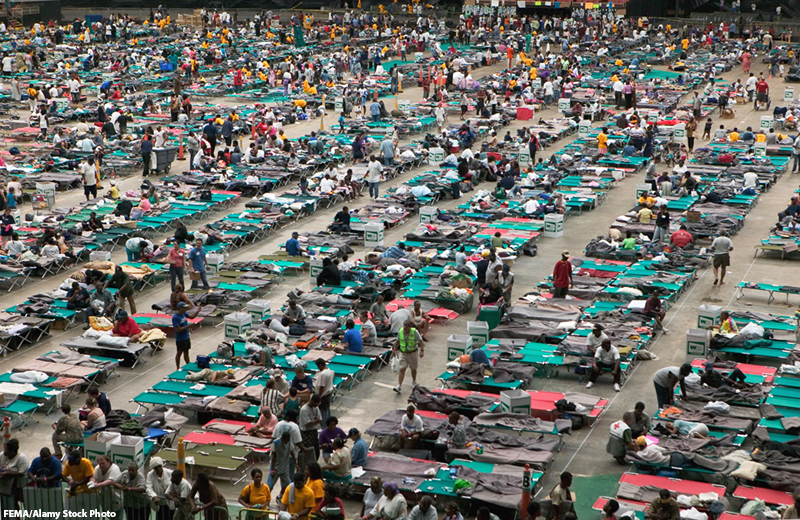
Twenty years ago, on August 29, 2005, Hurricane Katrina caused one of the worst natural disasters in United States history. Nearly 1,400 people died in the hurricane and the flooding that followed. Millions more people were left homeless. The storm caused around $200 billion in damage, making it the costliest storm on record. This week btw looks back at this unforgettable tragedy.
Hurricane Katrina’s Impact
Hurricane Katrina began as a tropical depression about 200 miles southeast of Nassau in the Bahamas. On August 25, 2005, the growing storm made landfall in Florida as a Category 1 hurricane. By the time it reached the Gulf of Mexico, it had intensified into a Category 5, with recorded wind speeds of about 140 miles per hour. When it made its second landfall in Louisiana, it had weakened somewhat into a Category 3. Nevertheless, the devastation was complete. The hurricane brought storm surge flooding of 20 to 25 feet above normal tide level, and thirty-three tornadoes spun off from it. While the entire Gulf coast was seriously impacted, the worst of the devastation occurred in New Orleans, Louisiana.
The National Weather Service had begun issuing evacuation warnings for the New Orleans and Baton Rouge areas on August 28. That same day, the Mayor of New Orleans issued the city’s first-ever mandatory evacuation. But evacuation wasn’t possible for everyone. More than a fifth of the residents of the city didn’t have access to a car. Others were physically unable to relocate or didn’t want to leave behind beloved pets. By the end of August 28, about 80 percent of New Orleans had evacuated. Of those who remained, about 10,000 chose to take shelter in the Superdome (a roofed sports arena in the city). Other refugees beyond New Orleans who lived along the Gulf Coast were displaced as well. Some even went to another domed sports area in Houston, Texas. Tens of thousands of others waited out the storm at their homes.

When the storm surge arrived, it completely overwhelmed the New Orleans’ levee system. Many of the residential areas of the city that were at or below sea level, so the levees (man-made flood walls to hold back water) were a very important storm safety feature. But many of these levees were old and in disrepair. Much of the flooded areas of the city also housed the poorest and most vulnerable residents. People in low-lying parts of the city had to climb onto their roofs to survive. By August 31, about 80 percent of the city was under water.
The Storm’s Aftermath
The Federal Emergency Management Agency (FEMA) was slow to respond to the scale of the Katrina disaster. FEMA took several days to set up rescue operations in New Orleans. Meanwhile, the Superdome was overcrowded and undersupplied, and survivors quickly grew desperate. Thousands of people where were not sheltered outside the Superdome remained stranded or were missing for days. Most lacked cars or other ways to escape the devastation. In fact, when a group of people tried to walk to a nearby suburb, armed police officers forced them to turn around and return to the Superdome. All in all, Hurricane Katrina was responsible for one of the largest displacements of people since the Great Depression.
What Has Changed Since Then?
Could a tragedy like Katrina happen again? Hurricanes and tropical storms are notoriously difficult to track. Change in wind speed and direction, combined with atmospheric moisture, can cause unpredictable shifts in any storm’s predicted path. The good news is that there have been drastic improvements to forecasting technology in the past 20 years.
In 2005, forecasters only had access to satellite images every half hour. But today, they can refresh satellite images as often as every thirty seconds. Unmanned drones are also utilized to help give us a better picture of developing storms. Today’s computer models are also more advanced and take into account forecast errors from the previous year. This reduces the error rate by about 50 percent. But forecasting is only part of the battle. Warnings must also be communicated in an effective way, with early warning systems and effective evacuation plans.
After Hurricane Katrina, Congress initiated a series of reforms to improve FEMA’s disaster response. This included billions of dollars in grants to FEMA to train people in disaster readiness. The Army Corps of Engineers also built a new system of levees and floodwalls around New Orleans. But science also shows that a warming ocean temperature increases the risk for stronger storms. Meteorologists do not know whether today’s new technological protections will be enough to prevent a similar disaster in the future.
